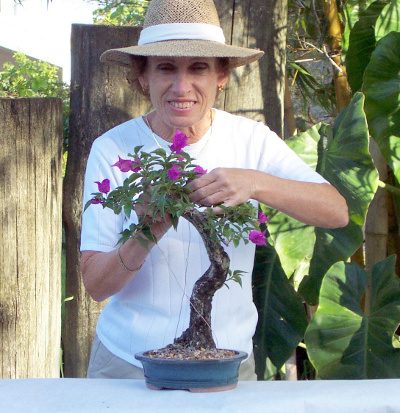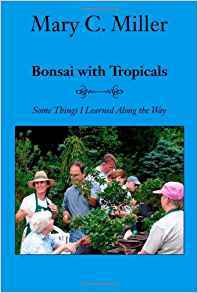| 11 |
1981 -- "An American Fantasy" was the title of the 5-1/2 foot long Bonkei (tray landscape) created by
Yuji Yoshimura at the International Bonsai Convention in Atlanta today. He was
assisted in the demonstration by long-time students Marion Gyllenswan and Phyllis P. Wishnick. The entire
1-1/2 hour program was coordinated by Edwin C. Symmes, Jr. Created by Mr. Yoshimura as a tribute to the
country that has supported his efforts in teaching and creating bonsai for over two decades, "An American
Fantasy" was comprised of three parts: 1) "The Rugged Mountains," 2) "The Verdant Hills," and 3) The Welcoming
Shore." The landscape depicted a cross section of the American landscape. Starting on the left with
the high mountain waterfall as a source -- and planted with dwarf juniper, Sawara cypress, Kingsville dwarf box
and azalea -- the water then runs through a rocky mountain gorge. As it enters the second tray, it flows
around a hill -- planted with dwarf juniper, serissa, andromeda, cryptomeria, and Trident maple -- and into a
pond before continuing out through the flatter landscape. The water continues past a hardwood area with
Trident maple in the third tray, into a swampy area with bald cypress and then into the sea. Every aspect
of the program was carefully chosen to heighten the dramatic effect. The lighting, music, and drama was
effective creating a very dramatic demonstration of the art involved in this creation. Typical of Yoshimura,
months were spent preparing the plant material and the entire tray landscape was actually assembled the week
before for Symmes to photograph. After the slides were developed the composition was taken apart and
replanted in to training containers only to be recreated at the convention. Then immediately following the
convention presentation, which was done in the dark with lights only on the plants and no photography permitted to
spoil the mood, a complete set of slides was available to memorialize the event.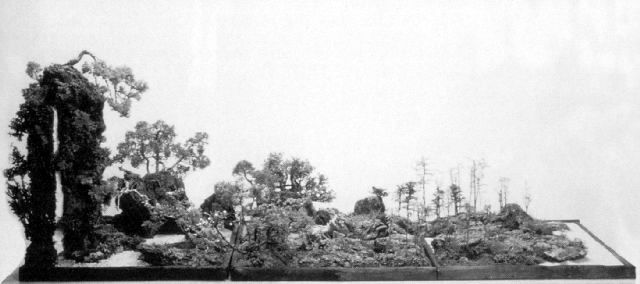
"An American Fantasy"
(Symmes, Jr. , Edwin C. "Bonkei - Saikei And Penjing," Florida Bonsai, Vol. XXXV, No. 3, Issue 143,
Aug. 2005, pp. 22/15; Valavanis, William N.
"Yuji Yoshimura, A Memorial Tribute To A Bonsai Master & Pioneer," International Bonsai, IBA,
1998/No. 1, pp. 38-39.)
(International Bonsai, 1998/No. 1, pg. 39) 2001 -- Ted T. Tsukiyama was formally presented with the Japanese Imperial Award of the Order of the Rising Sun with Silver Rays at a ceremony at the Japanese Consulate in Honolulu, Hawaii. The BCI Bonsai Magazine Contributing Editor and author, and a Past President of the Hawaii Bonsai Association, was acknowledged for his contribution to international friendships through bonsai and his life-long service to his community. This "decoration [was] for his efforts to build goodwill between Japan and the United States, to establish the World Bonsai Friendship Federation, and to improve the Japanese-American community. He was filled with emotion as he received the award from his former enemy and it strengthened his conviction that bonsai truly can be a vehicle for friendships and peace." 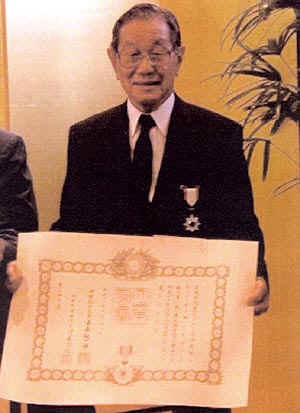
|
||
| 12 |
1952 -- Michael Persiano was born in Plainfield, New Jersey. [He would receive
a Bachelor of Arts and Masters degree from
Fairleigh Dickinson University, and
would be a Greek Studies doctoral candidate on a full academic scholarship at
Drew University. However, he would switch to
Forest Genetics and Ecology at Auburn University,
but then after a year, would realize that he was more interested in dwarfed trees than forests. He would
teach communications at Rutgers University. He
would become involved with bonsai in 1989 and collaborate with Master Chase Rosade on numerous advanced projects,
most of which would be documented in articles for Bonsai Today magazine. The work of Masahiko
Kimura would greatly influence his aesthetic development and lead to his interest in combining contemporary and
classical bonsai concepts. He would work in most traditional styles and specialize in material which calls
for carving. Michael would give workshops in the northeast and midwest sections of the country, and he
would take part in a lecture/demonstration tour for the French Bonsai Federation and also Australia. As an
author, he would have articles and photographs of his bonsai in magazines such as Bonsai Europe
(Focus), Bonsai France, International Bonsai, Bonsai Germany, Bonsai Denmark,
and Bonsai Sweden, as well as on several web sites. The May/June 1996 issue of Country Living
Gardener magazine featured Michael's work in an extensive article with 14 color photos that reached 1,000,000
readers and promoted awareness of this magnificent art. He is credited with devising the "chopstick method"
of monitoring the watering requirements of bonsai. (The basic idea is to insert a wooden chopstick into the
soil of each tree, and every day remove the chopstick and feel it. If the chopstick is WET -- don't
water. If the chopstick is DRY -- water immediately and thoroughly -- you have passed the time when the tree
needed to be watered. If the chopstick is JUST BARELY MOIST -- water fully -- this is supposed to be the
ideal time to water.) Michael also has been a strong advocate of "Superfeeding" -- a program designed to
accelerate growth in immature bonsai specimens to achieve design objectives over a reduced period of time.
Michael's web site would be
http://mpersiano.wix.com/michael-persiano-bonsai-studio,
and his e-mail address iasnob@aol.com.]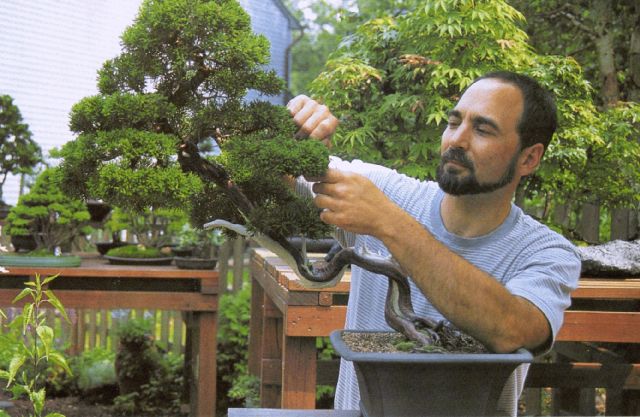
"Michael tends 'Flying Crane,' a 60-year-old Chinese juniper (Juniperus sargentii) named by him for its winged
form.
(Personal e-mails to RJB from MP, 9 November 2008; "Yama Ki Newsletter," November 2001, pg. 1,
http://www.yamakibonsai.org/Newsletter_pdfs.htm/Novermber.PDF;
Springfield Bonsai Society Palmatum Press, April 2008, pg. 1,
http://www.geocities.com/springfieldillinoisbonsai/SBS_Apr08.pdf;
"Innovative Consulting Hires Vice President of Marketing; Michael Persiano Joins Business Intelligence Thought Leader,"
TMCnet, February 09, 2005, http://www.tmcnet.com/usubmit/2005/feb/1115841.htm;
Buehler, George "Watering Bonsai," Greater Louisville Bonsai Society, July 1, 2004,
http://www.louisvillebonsai.org/post/2004/07/Watering-Bonsai.aspx.)
SEE ALSO: Jan 30, Mar 31
(Photo by Paul Kopelow, Country Living Gardener, May/June 1996, pg. 41, Fig. 2) |
||
| 13 |
1901 -- Kanichiro Yashiroda was born. [He would be a student gardener at the
Royal Botanic Gardens at Kew in London from May 1925 to May 1926, and then
a Brooklyn Botanic Garden correspondent since WWII. His home and
Acclimation Garden (Junkaen) would be located on
Shoda
Island, Kagawa Prefecture, just north of Shikoku Island and in Japan's Inland Sea. There he would
have "the largest number of genera and species of mature palm trees grown out of doors in Japan."
During WWII, he would be "obliged and forced to destroy most of them... to cut down and clear away many rare
trees and some of the commoner kind." (It is not clear how the destruction of his collection could
have aided the Japanese war effort.) Yashiroda would submit an article to Gardener's Chronicle
in 1930 regarding the Japanese technique of growing chrysanthemums in the 'cascade' style. He would also
contribute an article on "Notes on Varieties of Camellia Sasanqua" to the 1950 issue of The American Camellia
Yearbook. In 1952 Dr. George Avery, Jr. of the BBG would invite Yashiroda to be guest editor of a special bonsai edition of the BBG's educational quarterly. Bonsai
-- Dwarf Potted Trees would be published as the Autumn 1953 issue of Plants & Gardens and become an
overnight success. Then in the spring of 1955 the BBG would invite him to come, on a short-term fellowship
named in honor of C. Stuart Gager, to teach a bonsai class at the Garden. (This teacher would also be given
the Gager fellowship in 1963.) A May 23 Life magazine pictorial would have nine photos on Yashiroda
and his classes at the BBG. The following year he would have ninety-nine students. Handbook on
Bonsai: Special Techniques would be a companion BBG volume also edited by Yashiroda and released in 1956.
More than 150 students in all would register for his classes and take home the promising young trees they learned
to train and grow. And he would also receive the BBG's Forsythia Award this year in recognition of his
world-wide plant interests and his interpretation of the horticulture of his native Japan to the Western
World. His Bonsai, Japanese Miniature Trees -- Their Style, Culture and Training would be published
in 1960. He would die in the early 1980s.]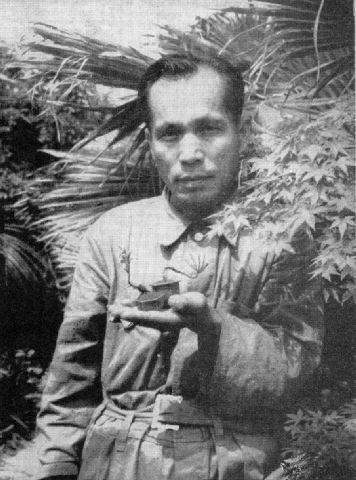
"[Kan Yashiroda] holding two miniature bonsai
(Per personal e-mail from Richard Kernick of Kew Gardens to RJB on 10 Nov 2006, and, by permission, excerpts
from Kernick's unpublished article "KANICHIRO (KAN) YASHIRODA: KEW STUDENT, BONSAI SPECIALIST, PALM COLLECTOR,"
e-mailed to RJB 17 Jan 2007; biographical info on inside front cover of BBG's Handbook on Dwarfed Potted
Trees; "Contents of 1950 The American Camellia Handbook,"
http://camellia-ics.org/_ics/journal/usa/us50.htm.)
SEE ALSO: Aug 3
(BBG's Handbook on Dwarf Potted Trees, pg. 27) 1904 -- George Muneichi Yamasaki was born in Osaka, Japan, to Zenkichi and Kikuyo Yamasaki. [George would come to the U.S. at age 13 to join his father in Auburn, CA. He would assist his father in growing fruit trees for sale to orchards throughout California, together they started a fruit tree nursery, and eventually become involved in both bonsai and suiseki.] ("OBITUARY: George Muneichi Yamasaki," Feb. 18, 2010 By Nichi Bei Web, http://www.nichibei.org/2010/02/obituary-yamasaki-george-muneichi/) SEE ALSO: Feb 13 1972 -- The first joint assembly of combined memberships of the Bonsai Clubs International and American Bonsai Society was opened in Kansas City, MO. Running through July 16, the event's official theme was "Learning Together." The guest artists were Yuji Yoshimura and Toshio Kawamoto. Some 400 persons were in attendance. ("Kawamoto Accepts Invitation to Bonsai Congress '72," Bonsai Journal, ABS, Vol. 5, No. 4, Winter 1972, pg. 63; "Letter From Our President," Bonsai Magazine, BCI, Vol. XI, No. 7, September 1972, pg. 5) SEE ALSO: Feb 24 2017 -- Long-time Melbourne, Australia bonsai patron Barry James Iles died. (Facebook posting by Lindsay Farr, 08/12/17) SEE ALSO: Nov 22 |
||
| 14 |
1914 -- Frederick W. Boehringer was born in
Bay City, MI to Albert G. and Wilhelmina (Klumpp)
Boehringer, Albert's second wife. "When it's flowers, say it with ours," was a slogan of Boehringer
Bros. Florists. Started by
brothers
Albert and Rudolf in 1893, the original one acre and 2 small greenhouses at 325 Park Avenue near Ridge Road
grew to over 12 acres with 13 greenhouses, 50,000 square feet "under glass" and 2 miles of steam pipes by
1914. [In the 1915 History of Michigan, author Charles Moore would cite a "Splendid establishment...
from their hothouses they supply more flowers than any other single establishment in northern Michigan."
They had 15 employees assisting them at the time. Near
Elm Lawn Cemetery, funeral
arrangements were a staple of their business, along with choice roses, chrysanthemums, and carnations. The
brothers made a special reputation in the growing of the latter, and improved several seedlings by hybridation and
fertilization until the Boehringer carnations were among the finest and most perfect flowers of the time.
Besides the local business, both brothers were technical and scientific men in their profession, and had a large
reputation as landscape gardeners, and among their work in this connection they assisted in the laying out of the
beautiful park system of Bay City. Frederick W., Albert's son, would start working at the greenhouse at age
12 and later inherit the business. It would later be moved to 114 S. Tuscola Road. The business would
be incorporated in 1965. Fred would be owner of Boehringer Greenhouses until his retirement in 1979.
In 1980 he would be named Retailer of the Year by the Michigan Floral Association. Boehringer's would be
closed in 1987 after 94 years in business, a year after Fred's wife, Doris, died. Fred would be a member of
Bethel Ev. Lutheran Church where he would serve as an elder, trustee,
school board member, choir director and organist. Fred would be a founding member of the San Toshi Bonsai
Society (in Midland, MI about a dozen miles to the west of Bay City), an honorary member of the
Bay City Garden Club, a member of the Saginaw Valley Orchid Society
and the Saginaw Gentlemen's Garden Club as well as a district representative for
F.T.D. He would be a member and past president of the
Bay Community Concert Association and would be a member of the
Saginaw Valley Lutheran
Chorale.]
("Frederick Boehringer Obituary,"
http://obits.mlive.com/obituaries/baycity/obituary.aspx?pid=181917888;
Bloomfield, Ron Lost Bay City, Charleston, SC: Arcadia Publishing, 2015, pg.
55;
Moore, Charles "Boehringer Brothers,"
History of Michigan, Vol. II; "Doris Boehringer (1913-1986),"
https://www.ancientfaces.com/person/doris-boehringer/53656396;
"Boehringer Greenhouses, Inc.," https://www.michigan-register.com/116774-boehringer-s-greenhouses-inc;
"Michigan Floral Association Industry Awards History 1950-2016,"
www.michiganfloral.org/wp-content/uploads/2014/09/awards_history_final_2016.pdf)
SEE ALSO: Oct 13
1941 -- Mary Stoute Miller was born in Washington, D.C., a fifth generation Washingtonian. [She would grow up in suburban Maryland, as the oldest of ten children. Even as a child, she would hate the cold weather there. She would dream of the tropics. In 1967, she would be working for United Airlines and take advantage of an opportunity to transfer to Miami. She would find that Miami was everything she had ever dreamed it would be. After a short winter season, United would want her back in DC, but she would decline. She would move herself and her children to the tropics and be there to stay. Very quickly, she would discover that in South Florida, if you stuck a stick in the ground it would grow. This would perk an old interest in horticulture -- including her learning about something by way of a copy of the 1965 Sunset Bonsai book she had on her shelf. [Jim Smith, up the coast in Vero Beach, had the first bonsai nursery she would ever see. He was a kind, gentle man and would be quick to share his knowledge. Mary would begin creating bonsai in Miami in the early 1970s. She'd be consumed with these little trees: reading about them, taking classes, experimenting, and, like many people, also killing a few. Bonsai would become a lifestyle, but at the time neither women nor tropicals would be very accepted in the bonsai world. In 1977, her hobby would turn into her first business, 'Bonsai etc.' a small retail shop, with just enough space for classes. She and a partner in this business would have a lot of tourist customers and order more pots, tools and books, but the monthly bills would come faster than the customer. At the time it would seem few people knew what bonsai was, so Mary would spend most of her time explaining, but six months later her partner bowed out and a year after that the shop would close. It would be a learning experience for her future ventures. In 1984, Mary would move to a fixer-upper house on one acre near Homestead, FL, just south of Miami. It would be perfectly suited for a nursery business. Local residents and guests from all over the world would visit 'The Bonsai Bench.' A few years later a five-acre wholesale location not far away ('The Big Five') would be added. Her brother Tom Stoute and daughter Angela Quinata would have joined her by then. During those years, the days would be long and the work was hard. They would create, grow and ship plants all over the United States, to Canada, Puerto Rico, and the Bahamas. The day that that first eighteen-wheeler pulled in the driveway and picked up a shipment of bonsai would always remain very clear in her memory. There would always be time to try out new possibilities. [After a little experimenting, one of their 'weed trees' would turn out to be an excellent subject. It wasn't long before they would be growing Leucaena glauca weed for bonsai, called 'Tropical Mimosa' for short. (Not related to temperate Mimosa.) She would also discover another winning subject and proudly introduce the tropical Nashia inaguensis, the Bahama Berry, as a new plant for bonsai consideration. In the 1980s, Dr. Wilson Popenoe, a former director of Fairchild Tropical Botanic Garden, would be the first to recognize the plant's potential with woody trunk, small leaves, tiny flowers and fruit, and point these out to the then bonsai instructor at Fairchild, Mary Miller. In 1991 she would begin a newsletter called "Bonsai Business." The next year everything would change when Hurricane Andrew would all but destroy their home and both business locations. The Bonsai Bench would limp on a few years before finally being closed. The devastation would be too great to begin again. Mary would then be able to accept out-of-town offers to speak in Montreal, Nassau in the Bahamas, and many cities throughout the US, and she would begin to write for garden magazines and national bonsai publications. She would take up drawing, painting and photography. Teacher John Naka would have told her earlier when he was in Florida that he wanted to invite her to come to California to demonstrate, but because she was a woman and creating tropical bonsai he "knew he would [receive] objections." Years later, though, in 2002, she would be a guest artist at the 25th annual Golden State Bonsai Convention in Sacramento, California. She would start a newsletter which would lead to her writing an 88 page paperback book in 2005 about her experience and experiences with bonsai, Bonsai with Tropicals, Some Things I Learned Along the Way (Trafford Publishing). It would get good reviews, but some would complain that it wasn't long enough, the pictures were black and white, the name was wrong, and the readers wanted more. Mary would give a lot of consideration to writing another book, but would then decide to create a website instead: BonsaiMary.com, which would include a monthly blog, Bonsai Banter. A not-always-traditional artist Joe Samuels and her would be bonsai friends for over 20 years going to meetings, workshops, conventions, etc. When Mary would be divorced for the third time in the late 1990s, Joe would ask her out. They would become close companions and live together for 10 years before his death in 2007. Joe and Mary would spend many winter days in the Everglades. Although they would have both done their share of collecting trees in "the old days," during those last years together they would have their cameras with them, instead of shovels. At the 2010 Bonsai Societies of Florida Convention, Mary would then be honored to receive the BSF Lifetime Achievement Award.]
1973 -- A group of men and women banded together to formally organize the Philippine Bonsai Society, Inc. (PBSI). (Commemorative stamps issued for 35th Anniversary of the Society) |
||
| 15 | 1997 -- Alan Stuart Roger died, three months after his exotic brother Neil, known as Bunny and famous in London society as a dress designer and for his theme parties, died. (Born in 1909, the eldest of the three sons of Sir Alexander Roger (1878-1961), a remarkable Aberdonian entrepreneur with worldwide banking and telecommunication interests, Alan was educated at Loretto School, and read history at Trinity College, Oxford. For a time then he worked as a broker. However, with the outbreak of war he was rapidly seconded to the Red Cross in France (his father had been appointed chairman of the Transport of Wounded Department, War Organisation of the British Red Cross Society). There followed service with the Ministry of Supply in India then the Indian Army, where Alan achieved the rank of lieutenant colonel and was subsequently awarded the MBE. By then his attachment to the Army way of life had become such that he stayed on after the end of hostilities, remaining with military intelligence until 1952, working largely in the Middle East and Far East. Returning to London, he brought with him a Chinese couple, Mr. and Mrs. To, and took on responsibility for the education of their three children. Sir Alexander Roger's extraordinary business acumen had enabled all of his family to live in considerable style, both before and after his death. In the mid-fifties a sudden realisation that a block of forgotten telephone shares were worth a great deal of money enabled Alan, Bunny, and their brother Sandy, to buy the 33,000 acre Dundonnell estate on Little Loch Broom in Wester Ross in the Scottish Highlands. Here Alan Roger created a magnificent garden. Early on his interests in growing things had extended to bonsai, and he was an annual exhibitor at the Chelsea Flower Show for 35 years. He also served as a judge for the Royal Horticultural Society. At Dundonnell, everything was on a larger scale, and the west coast climate proved ideal for the creation of a great walled garden. Becoming a vice-president of the National Trust for Scotland, Alan was an invaluable adviser when it came to the replanting of the trust's superb Rose Garden at Inverewe. But unexpectedly, it was his interest in Oriental and contemporary Western art which led to him becoming a director of the National Galleries of Scotland, where he became chairman of its advisory committee on modern art during the 1970s. Alan never dominated any committee, but had an invaluable international outlook, crucial in enabling the Gallery of Modern Art to develop its now quite remarkable collection. At the same time, the Roger wealth enabled him to become a notable collector himself. Every new year Alan and Bunny, neither of whom married, would hold a memorable party at Dundonnell where everybody had to join in the Scottish country dancing. In the grounds of the Trinity Hospice, Alan helped develop a water garden with kinetic sculpture. At the same time he served as a council member of the Contemporary Arts Society. He wrote the Wisley Garden Handbook Bonsai, published by the Royal Horticultural Society in 1981. A French edition followed in 1990, Italian in 1991, and Spanish in 1994.) [Alan's bonsai would become the property of the Scottish Bonsai Association. Many were stretched beyond Bonsai dimensions and styles but would be gratefully received as working stock for members. A small selection of his more interesting trees, including examples of Chamaecyparis and a huge Japanese White Pine would go into the National Collection Care for revival, refining/restyling and display. Others would follow in due course. Following a sale of the [non-bonsai] Roger Collection at Southeby's, the Dundonnell Estate would be purchased in 1998 by Sir Tim Rice.] (Martine, Roddy "Alan Roger," Herald Scotland, 9 Aug 1997, http://www.heraldscotland.com/sport/spl/aberdeen/alan-roger-1.385485; "National Bonsai Collection of Scotland," http://www.scottishbonsai.org/natcol.htm) SEE ALSO: May 12, Nov 22 | ||
| 16 | 1994 -- Kazuo Fujii, curator of the Brooklyn Botanic Garden's C.V. Starr Bonsai Museum, died. (A native of Japan, he had joined the BBG staff in 1979 to succeed retiring bonsaimaster Frank Okamura. A broom-style common Boxwood (Buxus sempervirens 'Suffruticosa') and wind-swept Key Lime (Citrus aurantifolia) he designed can be seen here.) ("In Memorium," Plants & Gardens, Vol. 50, No. 3, 1994) SEE ALSO: May 5 | ||
| 17 |
1976 -- A special two day bonsai exhibition honoring twenty-five years of instruction by Yuji Yoshimura began
today at the Yoshimura School of Bonsai. The featured trees for this came from the Muriel R. Leeds
Collection. A Commemorative Album would be published the following year.
(Yoshimura, Commemorative Album: The Muriel R. Leeds Collection, Briarcliff Manor, NY; 1977, pg.
61) SEE ALSO: Jan 12, Feb 27, Apr 23
1999 -- Mary Gertrude Parker Case, 82, died at Hilton Head Medical Center and Clinics in South Carolina. (She was born in Scranton, Pa., and went on to graduate from the School of Fine Arts of Syracuse University. Her graduate studies in ceramics were done at Ohio State University and she went on to teach ceramics at the University of Georgia in the early 1940s. She lived in Africa, India -- where she inaugurated the modern making of bonsai -- and the Far East for many years until the mid-1960s when her family resided in Bedford Village, NY, then relocated to Houston, TX in the early 1970s. She retired to Hilton Head Island in 1979. During her lifetime Mary continued her extensive interest in the arts, continuing ceramics as well as painting, crafts, photography, sewing, needlework and gardening. A founding member of both the American Bonsai Society in New York and the Hilton Head Miniaturists, she also taught ceramics at her home studio on Hilton Head.) She was a noticeable participant in the first three ABS conventions from 1968 to 1970, a Director in 1968-69, Secretary from 1969-71, and authored four articles in the ABS Journal in 1968 and 1969. (Personal e-mails to RJB from Roger S. Case -- Mary's distant 8th cousin by marriage -- 25 July 2005 and 22 March 2023; The Indices, ABS, 2004, pp. 12, 19, 44) SEE ALSO: Nov "Also This Month" (at bottom of page) |
||
| 18 |
|
||
| 19 |
|
||
| 20 |
1944 -- Walter Pall was born and grew up in the
mountains of Austria. [After completing his education in the U.S.
(University of Denver) and Austria
(University of Innsbruck) in economics, he
would serve as director of several large companies in the electronics industry. In 1978 he'd see a bonsai
exhibit at a local garden center in Munich, Germany which would be most intriguing: always keenly interested in
arts and horticulture, he could see here how both interests could be combined, and yet this seemed so difficult,
almost impossible. He would then purchase his first bonsai, which would die a few weeks later. In
1980 he would buy several again and never stop doing bonsai from then on. He would be one of the first
serious bonsai designers in Germany during these years. Deciding to drop out of the "rat-race," in 1991 he
would become an independent consultant near Munich in order to be able to dedicate more time to his trees.
Although he would have other interests and sources of income by then, he'd spend most of his time with and around
bonsai. He would open Bonsai Atelier (studio), which would be really a large collection of European specimen
trees along with a small shop offering hand-made pots for sale. [Walter would become one of the most popular bonsai artists to perform on many international stages. He would visit the vast majority of European countries and also South Africa, Canada, and the United States -- in a seven year period Walter would give more than 100 performances in America, mostly on the East Coast. His lectures would provide a basis of high quality bonsai work, add a substantial amount of explanation for the audience to clearly understand his development process, and also tell amusing anecdotes along the way. He would often be called a walking encyclopedia on bonsai and he'd share his knowledge freely. (In fact, for many years Walter would work on a lengthy and comprehensive encyclopedia about bonsai -- as yet unpublished.) He would receive several dozen national and international awards for his beautiful, dramatic bonsai. He would win the most prestigious Crespi Cup Award of Italy for his well-known Rocky Mountain juniper (Juniperus scopulorum), and would come in among the top six places every time he entered. Walter would also win second and third places in the Gingko Cup Awards of the Belgium bonsai competition held every two years. From 1993 to 1997 he'd be a member of the Board of Directors of the Bonsai Club of Germany, in 1996 be named a director of Bonsai Clubs International, and in 1997 be picked as vice president of the European Bonsai Association. [Walter would be one of the first Europeans to work with indigenous species, which he'd collect in his beloved Alpine mountains. By the turn of the century he would own a collection of more than 500 quality trees in varying stages of development and keep a store reserve of about 1000 handmade pots to compliment the bonsai. Besides his famous conifers he would also be well known for his beautiful deciduous trees. The longer he would be involved with tree development, the more he would move away from traditional bonsai styling to his own concepts of design. On August 28, 2001 the first annual "Yearly Late Summer Meeting" would be held at his 11-1/2 year old Bonsai Atelier. These would become THE meeting point of bonsai enthusiasts from all over Europe where one could watch new techniques, see one of the biggest collections of bonsai in Europe, THE biggest collection of outstanding bonsai material, and have a lot of fun for two days. He would also write and often provide photographs for more than 100 articles which would be published in Western bonsai magazines, and be a very active, vocal participant on the Internet in the bonsai scene. He would be married to Hanna, with one son, and live near Munich, Germany in sight of the Alps where he grew up and still loves to ski -- even participating in World Championships on the Austrian Skiing Team. [His philosophy would be stated as such: "I feel that it does not make much sense for you to see some European trying to show you what he thinks is Japanese bonsai. So I want to present my own bonsai philosophy. I start from the roots of what bonsai is all about. What is a bonsai? A bonsai is a small tree in a pot which touches my heart. It touches my heart because it conveys to me the spirit of a big tree out in the wilderness. To create a small tree that touches my heart and maybe someone else's. I have to go to the origin of that spirit. This would be the real trees out in the countryside, mostly in the mountains. Mind you, the origin is not the Japanese bonsai masterpieces. Then I go back and try to put this spirit into this piece of material that I am working on. While it is possible to do bonsai with all sorts of wooden shrubs, it helps a lot if the tree is a tree which comes from my beloved mountains. I try to give the feeling of the shapes of the trees that I saw and a feeling of the overall spirit of these trees. Mind you I said, 'feeling' -- I do not try to copy the shape exactly, but I try toget the 'feeling' of it. Then I try to put this tree into a pot that compliments it well. This may be a traditional imported one, but often it can be a different sort of container. The result can be called naturalistic bonsai. Some call it naïve art, some call it bad bonsai because it seems to be a step back from what we have learned so far from traditional instruction. ["This notion is understandable because I dare to break some taboos. I think that bonsai is no longer only a Japanese art form, but has become an international art form. Bonsai is not about playing only with Asian trees, it is about playing with trees native to your surroundings. Bonsai is not about trying to make a little tree look as much as possible like a Japanese masterpiece. I have learned from John Naka that bonsai is trying to make a little tree look like a big tree and not to make it look like a bonsai. ["To take a piece of material and form it into a bonsai is a type of abstraction. The Japanese have developed a very refined way of abstracting. We have learned a lot from them and still can learn a lot more from them. But we are not forced to copy forever. To copy is craft, to be and innovative is art. There are many ways or at least nuances of how to abstract a piece of material into a bonsai. Just think of the Chinese way which is often misunderstood as being inferior while it is just different. The outcome of my attempts may not always please the observer, nor does it always please me. But I attempt to go one step further than most and encourage all bonsai enthusiasts to give this some consideration. I have discussed these notions with some Japanese masters and I was most encouraged about their positive response." [In Oct. 2009, Walter started writing a multi-language blog. See also these two videos of his, 2007 demo in Croatia and 2010 demonstration at Noelanders Trophy XI His continual study and experimentation would lead to his revolutionary and seemingly radical technique and schedule of substrate-watering-and-fertilizing. There is this 2016 post to the Internet Bonsai Club which gives some more background and philosophy of his. This 2021 video of a few of his trees throughout the "Seasons."&nbap; And this January 2025 video of him explaining the BIG Difference Between Traditional and Naturalistic Bonsai Style.] 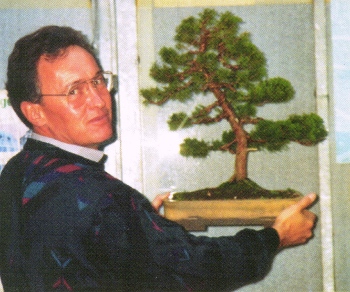
Walter Pall.
("About the Author," Bonsai Magazine, BCI, Vol. 35, No. 4, July/August 1996, pg. 8) 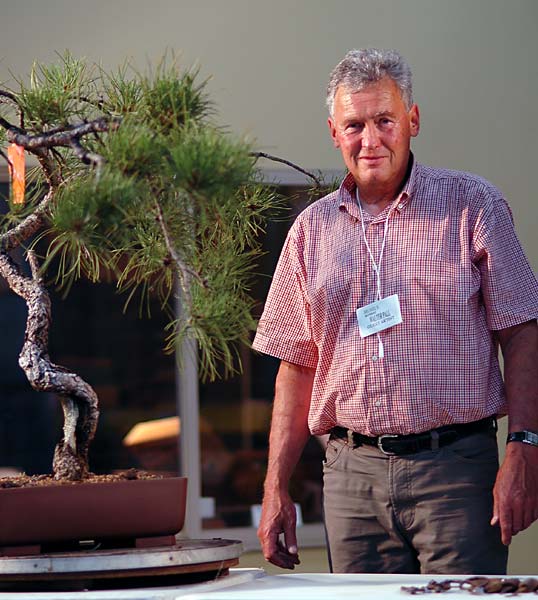
Walter Pall, 06/12/2006.
(Photo courtesy of Alan Walker, 05/11/07) (Personal e-mails with RJB Oct. 23 thru 27, 2002, which included bio by Jim Doyle, proprietor of Nature's Way Nursery in Harrisburg, PA, and WP personal philosophy as submitted to GSBF; "About the author" in "The carpinus betulus as bonsai" by Walter Pall, Bonsai Today #70 (2000-6), pg. 14; "About the Author" in "Collecting and Styling European Larch" by Walter Pall, Bonsai Magazine, BCI, Vol. 35, No. 4, July/August 1996, pg. 8.)
1990 -- "
Bonsai," a set of four
postage stamps, was issued by the Republic of China (Taiwan).
SEE ALSO: Jan 23, Jan 29, Feb 3, Feb 16, Mar 1, Mar 27, Mar 31, Apr 3, Apr 6, Apr 18, May 6, May 29, Jun
16, Aug 20, Aug 22, Sep 22, Oct 1, Oct 4, Dec 9.
|
